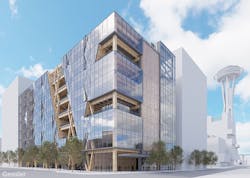Gensler Reimagines the Next Generation of Science Buildings Using Mass Timber
The Science Practice Area leaders at global design, architecture and planning firm Gensler recently completed a year-long research project focused on reimagining the next generation of science buildings using mass timber.
In a fast-growing market, the increased competition among science building developers is driving the demand for lab space and science workplaces and is challenging the status quo to create differentiation for tenants. Gensler identified a unique opportunity to develop a conceptual design that reimagines the life science workplace. Gensler’s Science Practice Area team conducted a research project funded by the Gensler Research Institute and in partnership with structural engineers at KPFF and mechanical, engineering and plumbing engineers at Buro Happold. The study measured the impact of a mass timber science building on tenants, the environment, and the community by prioritizing performance flexibility, market differentiation, climate readiness, and well-being.
“Our team recognized the issues plaguing the industry and saw an opportunity for innovation to optimize the lab design, create a unique tenant experience, increase product differentiation in the market, and offer solutions that prioritize sustainability, resilience, and decarbonization,” said Chad Yoshinobu, principal and global practice area leader of sciences for Gensler.
Lab Optimization, Health + Wellbeing
Gensler named its 250,000-square-foot, conceptual lab building “NEXT” and located it in Seattle’s Uptown Arts District. NEXT represents a point of differentiation, reinventing what a lab is from a sustainable, aesthetic, functional and optimized perspective. Designed with an offset core, NEXT provides maximum tenant flexibility for the lab/workplace at 33 x 33 feet. By optimizing the column grid to this unique layout, the lab bench can be oriented in either an east/west or north/south planning layout.
Although the size of this grid in mass timber doesn’t work well with vibration–a critical factor for every lab due to the sensitivity of lab equipment and the need to maintain consistent readings–Gensler partnered with KPFF to find a solution. Together they achieved a vibration of 6,000 MIPS, a go-to standard for most lab buildings.
According to the Gensler U.S. Workplace Survey, over one-third of science workers ranked outdoor space as their most desired workplace amenity. The shift of core components, including interconnecting fire stairs leading to a roof garden and balconies, also provides every floor access to outdoor space. NEXT also provides natural ventilation as a workplace component of the science building through operable windows. With fresh air as another highly rated amenity for science tenants, NEXT was designed with the ability to spend 34% of occupied hours in natural ventilation mode for the workplace portion of the floor, which helps yield energy savings.
Aesthetically, mass timber-framed buildings are naturally warm in comparison to concrete and steel structures, lending a pre-built finish to the interior, unlike the additional design elements needed to warm a concrete space. Externally, the NEXT design reinvents what a structural triangulated column can be on the perimeter.
Structural Resilience and Sustainability
NEXT prioritizes both construction efficiency and waste reduction, delivering a resilient building in a shorter speed-to-market time–30% faster to construct a mass timber structure than a conventional concrete lab building. Mass timber is particularly suited to off-site construction, which can be produced in a nearby factory and delivered to the site as a kit of parts, resulting in a 30% faster and 10% in cost savings for the construction process than a typical concrete building. With 85% fewer deliveries to the site and a 75% reduction in construction waste, NEXT uses 80% less carbon to build than a conventional concrete lab building. This amounts to a savings of approximately 5,200 total metric tons of CO2.
[Related: The Future of Textiles is Biobased]
Gensler extended the sustainable approach to the building’s operations, as well. NEXT uses an all-electric heat pump chiller (EL1) system, which is more efficient than a natural gas system. All-electric systems result in lower building EUI in all markets and achieve zero carbon emissions on a clean grid. In total, NEXT produces 50% less greenhouse gas emissions and uses 30% less energy annually than a conventional lab building.
Creating a Synergy With the Community
Gensler wanted to demonstrate how a science building could be a community catalyst to benefit the local district by creating opportunities to activate public programs at the ground floor. NEXT was designed to host a multipurpose arts and entertainment venue, as well as a shared incubation restaurant and shared kitchen space to celebrate the diverse culinary arts in the city.
NEXT looks beyond the perimeter of its walls to stitch together an approach that benefits its community creating a synergy between community and building. Prioritizing both construction efficiency and waste reduction, NEXT delivers a resilient building in a shorter speed-to-market time. It allows architects and designers the flexibility to create beautiful, sustainable, and versatile buildings; provides developers with a differentiated product that stands out from the competition; empowers tenants with optimized workspace planning; and bridges a synergistic connection to the community. NEXT redefines the science building of the future.
For more information, visit gensler.com.
Read next: How to Specify Climate Positive Materials
